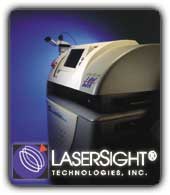|
Whether we realize it or not, technology affects every aspect of our lives. From the cars we drive to the computers we depend on, ever advancing technology has made it possible for us to live in our modern world.
Science is constantly changing and evolving, pushing the limits of knowledge and understanding beyond all expectations.
In this spirit, Maddox Laser Eye Center is pleased to offer the latest in advanced Laser Vision Correction to reduce or eliminate the need for glasses and contact lenses. Employing a state-of-the-art on-site excimer laser system - the LaserSight LaserScan LSX® - Dr. Maddox can treat nearsightedness, farsightedness, astigmatism, and mixed astigmatism using the latest LASIK and PRK corrective techniques.
Laser Vision Correction Technology...
Over the last two decades, Laser Vision Correction technology has been continually advancing and improving. Using some of the newest and most advanced technology available today, the Maddox Laser Eye Center, with its on-site excimer laser system, is providing patients the highest level of care at an affordable price.
Find out about the technology that could help you see your world in a new light.
LaserScan LSX® - The Gentle Touch in Laser Vision Correction
 LaserSight LaserScan LSX® LaserSight LaserScan LSX®
The LaserSight LaserScan LSX® Excimer Laser offers precise, accurate, and most importantly, smooth tissue removal. The LaserScan LSX® is a true scanning spot laser with a 0.8mm "Flying Spot" beam that can provide a smooth, even treatment of the corneal surface -- crucial to achieving optimum post-operative vision. This cool beam of light is used to gently and precisely reshape the cornea of the eye. LaserScan LSX® is the Gentle Touch in Laser Vision Correction.
LaserSight Technologies, Inc. is a world leader providing precision laser scanning systems and other technology solutions for laser refractive surgery.
LaserScan LSX's FDA approved indications for use in the United States.
Nidek MK-2000 Microkeratome for LASIK
 Nidek MK-2000 Microkeratome Nidek MK-2000 Microkeratome
The Nidek MK-2000 Microkeratome represents a technological leap beyond other microkeratome systems. With its single-unit design and no gear mechanism, the Nidek MK-2000 makes LASIK easier for both the surgeon and the patient.
The automated microkeratome is a small mechanical device used to create a hinged corneal flap during the LASIK procedure. The device is placed on the eye and a light suction is applied to ensure proper contact with the microkeratome. A tiny oscillating blade is mechanically moved along the built-in sliding guide, creating the corneal flap.
Selected portions of text as well as images are copyright by their respective owners. Images and text were used with permission. For more information about the companies involved, please see their corporate websites: LaserSight | Nidek
Excimer Laser Technology Explained...
Excerpt from Patient Education Brochures developed by Dr. Bobby Maddox, M.D.:
The Argon-Fluoride Excimer Laser is a revolutionary innovation and advanced treatment modality in an attempt to correct myopia, hyperopia and astigmatism, as well as superficial keratectomy to erase corneal scars and irregular corneal surfaces. When the Argon-Fluoride Excimer Laser is used in corneal reshaping to correct refractive errors, it breaks the carbon-to-carbon molecular bonds of the corneal tissue by the ultraviolet 193-nanometer wavelength of emission photochemical effect called photoablation. This photoablation effect is extremely superficial. Minimal thermal damage is created by the ultraviolet excimer laser, unlike traditional lasers in which the produced heat causes damaging effects to surrounding tissue. The pulsing excimer laser removes the tissue in microscopic layers, leaving virtually no underlying thermal trauma. The carbon-to-carbon bond holding most of the tissue together has an energy requirement of 3 electron volts. If an excimer laser photon is introduced, it can literally crack that bond. The photon-energy, or energy per photon, of the excimer photon is 6.4 electron volts, or 10-15 millijoules per photon. One laser pulse contains many photons. One excimer laser pulse contains 2.5 x 1016 photons. Therefore, the energy per pulse at the eye is equal to the 10-15 millijoules (single photon energy) times 2.5 x 1016 (number of photons in one pulse), which equals 25 millijoules (mj). (2.5 x 1016 = 25 billion million.) These excimer photons are like "photon scissors", breaking the carbon-to-carbon bonds of the corneal tissue. Hence, the excimer photon is incredibly energetic, having 3 times as much energy as the YAG laser photon and more than twice the energy as the Argon laser photon. The term that has been coined for the effect of the excimer laser on the tissue is photoablation. The key to the excimer laser is the short pulse duration (10 nanoseconds or 10 x 10-9 seconds) with high energy photons (energy per pulse is 25 millijoules at the eye) with the possibility of concentrating large numbers of these photons on tissue to crack the carbon-to-carbon bonding that holds tissue together.
For the first time, a no-touch system, or no-touch scalpel, with the ultimate resolution of a fraction of a micron, is available to surgeons. (One micron equals one one-thousandth of a millimeter.) So, without touching the eye, the excimer can change and sculpt the cornea (photon scissors) incredibly accurately with virtually no collateral damage conducted into the edges of the tissue affected. There is no significant mechanical effect to the surrounding tissues; and no crushing of tissue, as with a knife blade or scalpel.
|